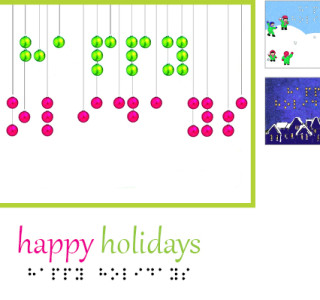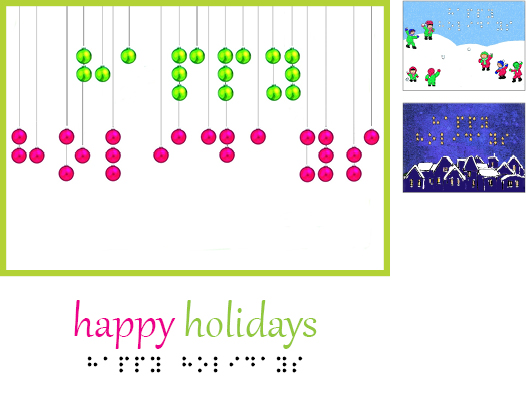
Tips for Sending Accessible and Enjoyable Greeting Cards and Pictures
Now that you have some ideas from last week’s post on what to give your friend or family member with vision loss, it is time to revisit the topic of holiday greeting cards and pictures. Everyone appreciates receiving greeting cards, and there are many options for people who are blind or visually impaired. Simple suggestions and even creativity can help you come up with a greeting card or picture album everyone can enjoy!
Braille Greeting Cards
Several organizations that work with people who are blind or visually impaired sell Braille greeting cards. The Chicago Lighthouse’s Tools for Living Store, for example, sells a wide variety of greeting cards for different occasions. A Braille message is included in each card, and space is provided for you to write a personal message. If you know Braille or someone who does, you can write your message in Braille!
Tactile cards
Some greeting cards already have raised or embossed images. A lot of times the paper has simple embossed designs, and other cards have tactile shapes made from materials like felt or glitter. I personally appreciate it when someone gives me one of these cards (although sometimes they do it without realizing it). The down side is that they might cost more than standard cards. If you’re the creative, do-it-yourself type of person, then you can easily make a tactile greeting card. You can find thousands of styles and design ideas online.
E-Cards
These are digital greeting cards that are sent through email. They often include picture animations and short audio clips. You can even personalize the cards with your own pictures and short audio recorded messages. I have a love-hate relationship with these types of cards. Although I can easily click on the link to view the card, I often have no clue what’s in the animation or pictures. Animations aren’t always accessible with screen-reading software, and more often than not, the images aren’t described. I remember once getting a Christmas Hallmark e-card, and although I could hear “jingle bells” playing in the background, I had no idea what the images were.
Describing Pictures
Sharing pictures is increasingly popular thanks to social media. Just like anyone else, blind and visually impaired people love receiving pictures of their friends and family, and of course any photos we might be in! No matter how you send the photos – through email, Facebook, Twitter, etc. – it’s always a good idea for you to add a brief caption describing who and what is going on in the picture. Of course, if your friends or family members with vision loss were in a particular photo, chances are they will remember when it was taken. By providing brief descriptions, we will be able to enjoy these snapshots as much as everyone else!
Regardless of what method you use, those of us who are blind or visually impaired will greatly appreciate the effort you put into sending us a card or photo we could enjoy. Even if the message in the card is handwritten, we will most likely find someone who can read it and describe the picture for us. Still, finding a card that is accessible can help us read and enjoy it on our own. I hope these tips and suggestions will help you get your loved ones with vision loss greeting cards that are accessible and enjoyable. Happy holidays!

Sandy Murillo works at The Chicago Lighthouse, an organization serving the blind and visually impaired. She is the author of Sandy’s View, a bi-weekly Lighthouse blog about blindness and low vision. The blog covers topics of interest to those living with blindness and vision impairments. Being a blind journalist and blogger herself, Sandy shares her unique perspective about ways to live and cope with vision loss.






